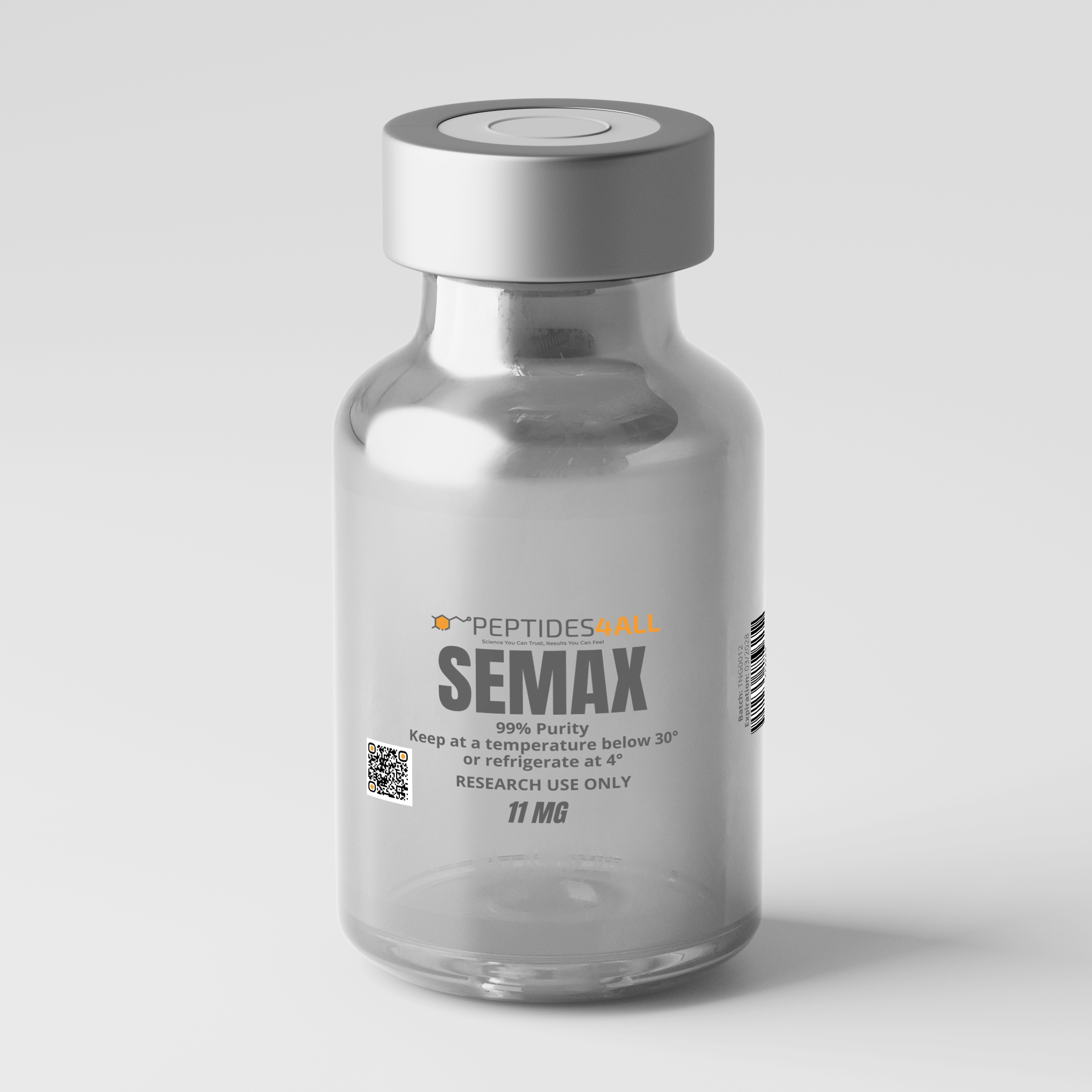PEPTIDES4ALL Semax – Neuroprotective & Cognitive Enhancement Research Peptide
PEPTIDES4ALL Semax is a synthetic heptapeptide (Met-Glu-His-Phe-Pro-Gly-Pro) derived from the adrenocorticotropic hormone (ACTH 4–10) fragment, engineered to preserve its neurotrophic and neuromodulatory effects while eliminating hormonal activity.
This selective design allows Semax to act as a non-hormonal regulator of neuronal function, stress adaptation, and cognitive performance, making it one of the most extensively studied neuropeptide-based agents in post-ischemic and cognitive research.
Its unique profile—combining neurotrophic stimulation, transcriptional regulation, and stress-adaptive signaling—makes Semax a leading research compound in models of ischemic injury, neurodegeneration, and cognitive enhancement.
Semax belongs to a class of synthetic regulatory peptides that modulate neural and immune gene networks, enhancing brain resilience under ischemic and oxidative stress conditions.
By stimulating brain-derived neurotrophic factor (BDNF) and TrkB receptor pathways, Semax promotes synaptic plasticity, neuronal survival, and long-term potentiation—key molecular processes underlying learning and memory (PubMed, 16635254).
Unlike conventional nootropics that act primarily through neurotransmitter modulation, Semax operates at a transcriptional level, regulating gene expression across immune, vascular, and neuroprotective signaling cascades (PMC3987924).
In preclinical and clinical studies, Semax has demonstrated remarkable neuroprotective activity in models of stroke, hypoxia, and ischemia-reperfusion injury, where it helps normalize inflammatory cytokine expression, restore dopaminergic and serotonergic balance, and support neuronal recovery (MDPI Genes, 2020).
Its multi-layered mechanism—spanning BDNF upregulation, monoamine modulation, and immunotranscriptional control—has led to its clinical application in post-stroke rehabilitation and cognitive impairment syndromes in several countries.
At the molecular level, Semax also interacts with the melanocortin receptor system (MC3R/MC4R), potentially modulating neuroendocrine and autonomic functions associated with stress resilience and neuroinflammation.
Through these combined effects, Semax acts as both a protective and restorative neuromodulator, aligning it with current research on endogenous neurotrophic signaling, peptide-based neuroprotection, and translational neuroscience models.
With its high purity, reproducible biological activity, and established neurotrophic profile, PEPTIDES4ALL Semax provides researchers a robust tool for investigating BDNF-mediated repair mechanisms, neuroimmune cross-talk, and adaptive gene regulation in models of stroke recovery, cognitive enhancement, and neuroinflammatory control.
Scientific Evidence & Research Findings
Multiple in vivo and in vitro studies have characterized Semax’s neurotrophic, genomic, and receptor-mediated actions, including the following findings
- Semax administration increases BDNF protein levels in the rat basal forebrain after intranasal dosing.
https://pubmed.ncbi.nlm.nih.gov/16635254/
- Genome-wide expression studies (in ischemic rat brain) show that Semax profoundly influences immune, vascular, and neuroprotective gene networks.
https://pmc.ncbi.nlm.nih.gov/articles/PMC3987924/
- Semax is used in Russia for stroke recovery, where it has shown capacity to suppress inflammatory gene expression and restore neurotransmission in ischemia-reperfusion models.
https://www.mdpi.com/2073-4425/11/6/681
- As a synthetic derivative, Semax may act as a melanocortin receptor (e.g. MC3R / MC4R) antagonist in some contexts, adding modulatory capacity.
Key Research Benefits & Applications
-
BDNF-Driven Neurotrophic Activation: Potently upregulates brain-derived neurotrophic factor (BDNF) and its receptor TrkB, stimulating neuronal survival, synaptic growth, and long-term potentiation—molecular foundations of learning, memory, and post-injury recovery.
-
Transcriptional Regulation & Gene Network Modulation: Acts at the genomic level to influence hundreds of genes involved in immune response, angiogenesis, oxidative defense, and neuroplasticity, distinguishing it from neurotransmitter-only nootropics.
-
Monoaminergic & Neurotransmitter Balance: Normalizes dopaminergic, serotonergic, and GABAergic activity, promoting emotional stability, focus, and stress resilience through balanced monoamine signaling.
-
Neuroprotection Under Ischemic or Hypoxic Stress: Demonstrates robust neuroprotective effects in models of stroke and reperfusion injury by reducing oxidative damage, stabilizing mitochondrial function, and restoring neural connectivity.
-
Immunomodulatory & Anti-Inflammatory Action: Suppresses pro-inflammatory cytokine expression and modulates neuroimmune gene networks, supporting neuronal repair and protecting against neuroinflammatory degeneration.
-
Melanocortin Receptor Crosstalk: Interacts with MC3R/MC4R pathways, offering insight into stress-adaptive neuroendocrine signaling and potential regulation of autonomic and vascular tone.
-
Broad Cognitive & Translational Applications: Serves as a multi-mechanistic research model for studying stroke rehabilitation, cognitive enhancement, neurodegeneration, and peptide-based neurotherapeutics.
Presentation & Handling
- Form: Supplied as lyophilized peptide in sterile vial.
- Reconstitution: Use bacteriostatic water or 2% procaine; swirl gently (do not shake vigorously).
- Storage: Store at –20 °C, protected from light and moisture. After reconstitution, use according to research protocols and handle under sterile conditions.
Intended Use
For research purposes only. Must be handled in accordance with institutional protocols and ethical guidelines.
